

Eternal doesn't have sideboarding per se, but in June, the fourth set introduced the Market meant to act as a sort of live sideboard, via a cycle of five merchants.
Your Market consists of five cards that count against your 4x deck limit but are not part of your deck. (In that way, it's exactly like a sideboard but 1/3 the size.) Because Eternal only has single-game matches, though, the way you utilize the Market is different: When you play a merchant, you can draw a card from your Market by putting a card from your hand back in its place. You sideboard in the moment.
It's so neat that you can adjust your deck strategy for a match-up mid-game. I don't want to maindeck Infinite Hourglass, but having access to one when I face an opponent packing 4 Permafrost and 4 Ice Sprites is really nice. I don't always want Dispel or Passage of Eons, and being able to get one when I do is great.
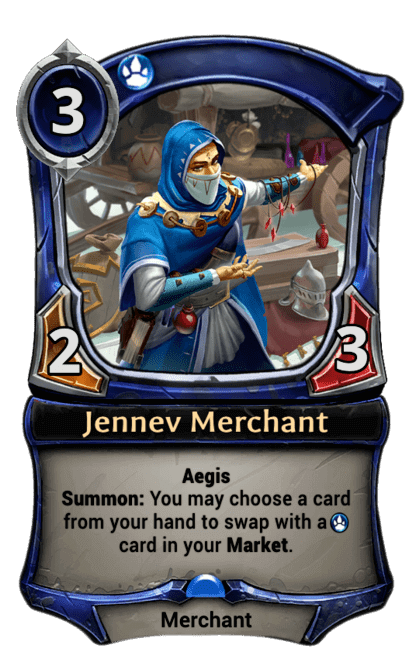 All five merchants cost 3 and require a single influence of their faction. Except for Auralian Merchant's +1 Max Power ability, each has a keyword and stats to make it feel more like its faction. Finally, merchants can't go and grab just any card from your Market, it has to match their faction. You could put both Fire and Primal cards in the Market of your Fire+Primal deck, but your Jennev Merchant won't be able to get Great-Kiln Titan and your Ixtun Merchant won't be able to get Scourge of Frosthome (but either can get Molot & Nakova). Since you're already limited to just five cards, what that means is every deck really wants to choose one faction's merchant and put cards of that faction or both in its Market.
All five merchants cost 3 and require a single influence of their faction. Except for Auralian Merchant's +1 Max Power ability, each has a keyword and stats to make it feel more like its faction. Finally, merchants can't go and grab just any card from your Market, it has to match their faction. You could put both Fire and Primal cards in the Market of your Fire+Primal deck, but your Jennev Merchant won't be able to get Great-Kiln Titan and your Ixtun Merchant won't be able to get Scourge of Frosthome (but either can get Molot & Nakova). Since you're already limited to just five cards, what that means is every deck really wants to choose one faction's merchant and put cards of that faction or both in its Market.Are they any trends how players build their Markets? Yes. Because merchants are tutors, and the market is our clip of silver bullets, there is a correct form for all Markets.
If you're not a hyper-aggressive deck that tops out at 2-3 mana, you really want to have a power card in there to help you make your land drops. If your deck is more than one color, than you really want it to be a banner since you can expect you'll have a unit (the merchant itself) when you get it.
You want 1 or 2 counters to problematic strategies. Ideally, these aren't 1:1 answers, but sweepers or rules-setters that disable 4+ of your opponent's cards. These are the Infinite Hourglasses and Passages of Eons I mentioned above.
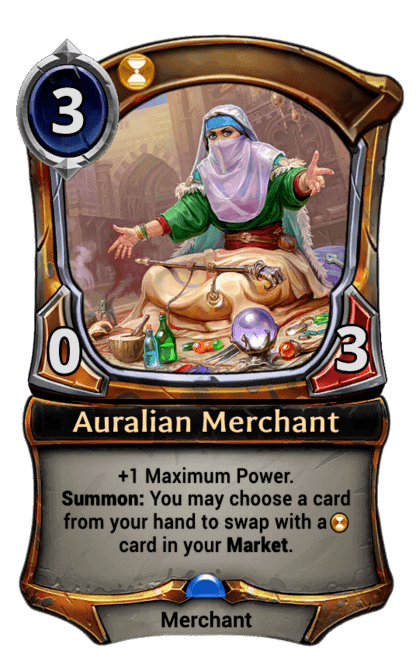 You want the single most expensive card in your deck, so you never draw it early. Finally, you want 1 or 2 key cards that really make your deck shine, preferably starting at 3-5 mana (because you know you'll have 3 power when you untap after playing a merchant, unless it was Auralian, in which case 4). Starting players might only have one legendary card relevant to their deck, and if you've got 2+ merchants, that vastly increases how often you'll get to draw it. That's great.
You want the single most expensive card in your deck, so you never draw it early. Finally, you want 1 or 2 key cards that really make your deck shine, preferably starting at 3-5 mana (because you know you'll have 3 power when you untap after playing a merchant, unless it was Auralian, in which case 4). Starting players might only have one legendary card relevant to their deck, and if you've got 2+ merchants, that vastly increases how often you'll get to draw it. That's great.Invested players will always be playing 4x of their chosen merchant and will often be running 3x of their best cards main with the fourth in the Market, giving them essentially 7 chances to draw it. This combination of factors drastically reduces variance in deck-building and gameplay. That's a good thing, right? Because Eternal has too much variance? Well…
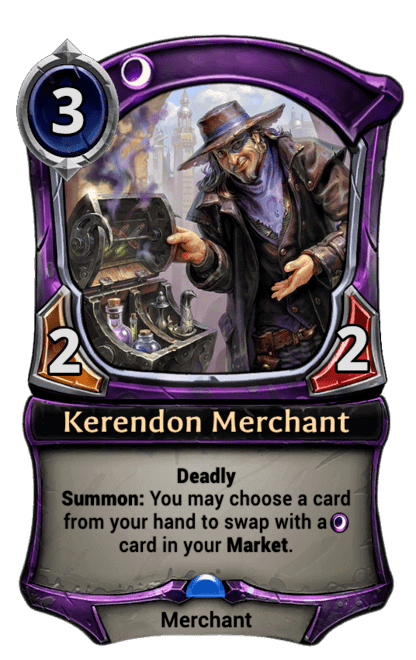 Yes and No. Reducing variance in deck-building is mono-bad, because it removes agency from players and reduces the excitement to discover each new opponent's deck. Mitigating the variance endemic from 75-card decks is definitely good. Mostly. It's a suboptimal form of mitigation because it's so predictable and creates repetitive gameplay patterns across the entire card game. Every deck is going to get to 4 power after it gets to 3, and find that one broken card, and have a killer closer.
Yes and No. Reducing variance in deck-building is mono-bad, because it removes agency from players and reduces the excitement to discover each new opponent's deck. Mitigating the variance endemic from 75-card decks is definitely good. Mostly. It's a suboptimal form of mitigation because it's so predictable and creates repetitive gameplay patterns across the entire card game. Every deck is going to get to 4 power after it gets to 3, and find that one broken card, and have a killer closer.In case you doubt how accurate my assessment is, I worked all this out, then googled and found the exact same sentiment here.
I can expect my opponent to play a merchant on turn 3 in Ranked mode exactly as often as one is likely to draw a copy from a playset in a 75-card deck… minus them drawing a stronger three-drop or missing their third land drop. When they do play a merchant, I can predict their entire Market with about 70% accuracy, and may or may not have a very strong idea what card they just grabbed based on the current game state. Early Time-Shadow deck? Xenan Banner. With 7+ power? Azindel. With an the Auralian Merchant, it's Disjunction, Decay or Passages of Eons if I've got relics and Sandstorm Titan or Alhed, Mount Breaker if not. If the merchant is Kerendon, and I've got a Justice creature, it's In Cold Blood; if it's another monofaction creature, it's Annihilate. Otherwise Vara, Vengeance-Seeker or a discard spell.
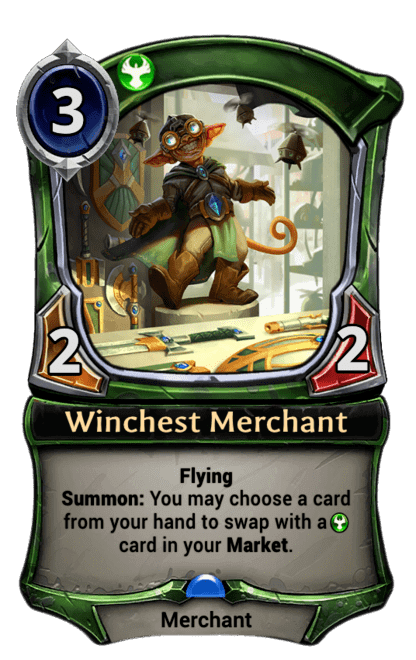 That's a problem. Players get tired of facing the same over-powered BS over and over again, but even more they hate predictability. We wouldn't be playing a game with a shuffled deck otherwise. Merchants are brand new relative to Eternal's life span and a lot of players are already sick of them. Things will improve: As more cards are introduced into the available pool, it'll be harder to predict exact Markets. They could also introduce new Merchants, so that at least we're not seeing the same five faces every match. But those improvements are marginal and will be slow in coming.
That's a problem. Players get tired of facing the same over-powered BS over and over again, but even more they hate predictability. We wouldn't be playing a game with a shuffled deck otherwise. Merchants are brand new relative to Eternal's life span and a lot of players are already sick of them. Things will improve: As more cards are introduced into the available pool, it'll be harder to predict exact Markets. They could also introduce new Merchants, so that at least we're not seeing the same five faces every match. But those improvements are marginal and will be slow in coming.How else could we improve the situation? I'm not seeing a lot of obvious answers.
• If the goal is really just to allow sideboarding mid-game, we could errata Merchants so they don't also act as tutors: Have them change all copies of card X in your deck to card Y in your Market. Or even just choose a card in your Market and shuffle 4 copies into your deck.
• If the higher purpose is to reduce variance, we could forget the Market and have merchants move a card (or class of cards) of your choice closer to the top of your deck. Or we could forget merchants and tweak the algorithm to silently interfere with deck order to reduce non-games.
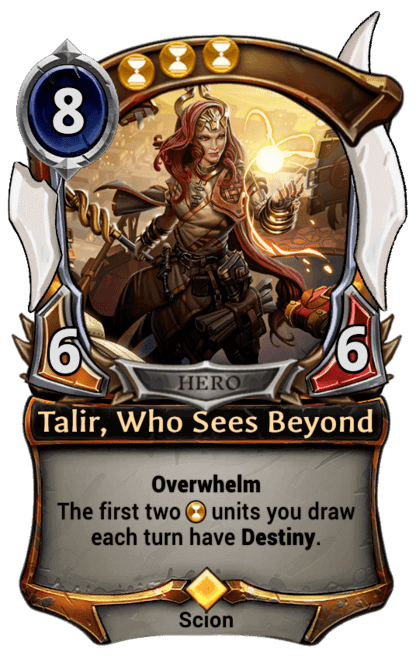
• We could split the difference by modeling Revenge: "Choose a card from your Market and shuffle a copy into the top 10 cards of your deck. It gains Destiny." I mean, we can't let you give The Witching Hour destiny, so we either omit that and put it in the top 5, or we only give it destiny if it costs 4 or less. "It costs 1 less for each card above it" might work, but is a bit inelegant for Eternal.
• We could reduce the ubiquity of merchants by reducing their power level. +1 cost without any benefit would dissuade a lot of players. Making them spells instead of units would greatly reduce their utility.
(One of the big benefits of an exclusively-digital game is that you can errata cards as much as you have to. Eternal smartly lets players unbuy copies of cards they've recently nerfed so this causes less backlash.)
Do you have other complaints or defenses of merchants or the Market? Other solutions?

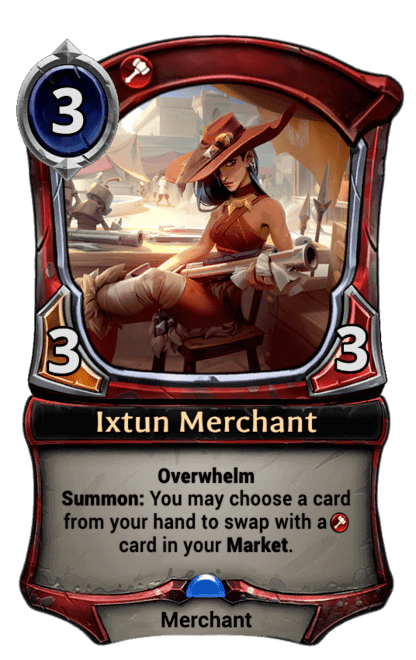
My suggestion when they were spoiled was not to allow any overlap between your market and your main deck, so you at least prevent people from just using them to play 7 of their most powerful cards. That put's the focus more on narrow answer cards like a Sideboard would be used for, and you could potentially increase the size of the market to allow for more flexibility there.
ReplyDeleteThat definitely helps address the 7-of issue.
DeleteWhat about instead of giving it Destiny, we give it Warp? That way you're effectively drawing it, but not getting the discount.
ReplyDeleteI think if we want to compare the Market to Magic, it might be more accurate to call it a Wishboard, since the merchant act a lot like the wish cycle.
Put the card from the Market into the top 10 cards of your deck and give it warp?
DeleteI love it.
Merchants are problematic because of being good units in addition to the "wish" effect, so you're never giving up tempo to play them.
ReplyDeleteAuralian was stupid good against aggro decks before its nerf, being a ramp card that could both hold off 3/3s and eat X/1 bodies for free. The others aren't that much worse off. Ixtun is great with any pump effect, Jennev is hard to remove (and pretty hilarious with recursion in the Feln deck), Kerendon usually trades up, and Winchest is still "fine" as a Wind Drake.
I don't like the idea of making them more expensive because it just adds more variance by making them bad at Civic Wayfinder duty, and one of the things I most enjoy about merchants is the guessing game you have to play when you need a body on-curve but the opponent's board hasn't developed much yet. I'd rather make all the bodies a little weaker. Some aggro builds don't even want Merchants as 3-drops as is.
In addition, I'd suggest a piece of tech that Eternal-as-digital-platform has actively shied away from using: Show the market card to your opponent when you draw it, not just when it's played (there's a little animation for that). This gives the opponent more potential for counterplay, perhaps with a Merchant of their own.
Also, you barely touched on how the card-swapping ability of Merchants affects gameplay.
Delete-If I have a spare Power, I want to hold it in hand, because I can send it to the Market if I draw a Merchant later. In this respect it's much like jump-start.
-Likewise, if I can make my opponent discard a lot of cards, their Merchants get worse.
-I can send a card into the Market with one Merchant and tutor it back out with my second Merchant, adding even more potentialities to late-game market usage.
-If my entire hand is great, I can choose to not swap, giving it a Vendilion Clique-esque level of flexibility... but if I really need that fourth Power, I get to feel bad.
Thanks for sharing this gameplay implications. All so true.
DeleteI hadn't noticed there's an animation when you play a card you got from the Market. Huh.
One factor that mitigates the decrease in deckbuilding variance is synergy. If you play four Merchants, you get to play much crazier, more situational cards in your 75, because you have a failsafe in the event that you draw them dead. Interactions with cards that put marginal extra cards in your hand are also great; Granite Waystone and Jotun Hurler have seen high-level play just because they create Merchant fodder, and I very much enjoy messing around with Manufacture and eight Merchants in the casual room.
ReplyDeleteIn terms of how to alter Merchants, the mechanic they actually use is the Market, which is just a collection of five cards outside the game. There are tons of ways a designer could utilize it:
-- As Jade suggested above, cards in your market can't also be in your deck. I had that idea too; it's quite simple and addresses the 7-of issue, and I wouldn't be surprised if DWD goes in that direction someday.
-- Restrict the cards you exchange; say, the card you send into the market must share a quality with the one you take out. Likely this would just be faction; cost or card type would likely constrain the gameplay too much. I could see a Merchant that makes you exchange for a costlier card, a la Whispering Wind.
-- Your opponent gets to make an exchange too. I'd love to test this one, as it seems insanely high-risk, but the payoff's there and it could lead to some amazing story equity.
"That's a problem. Players get tired of facing the same over-powered BS over and over again, but even more they hate predictability." - Jay
ReplyDeleteThis is why I quit Eternal after a year of play. The grind to Master was enjoyable, and the deck tracking I did for myself helped me as a deck builder in Magic, even after 20+ years of playing the game.
Aggro decks don't even need to run them, adding to the frustration those players feel watching their opponent grab another board wipe.
10 games, 10 merchants, 10 Hailstorm and I saw the writing on the wall. I bailed from the game.
One solution is bump up the cost of the merchant by 1. Turn 3 draw of guaranteed board wipe removes the aggro safety valve that games need so that they don't become turbo solitaire. Push the ability to play that card to one turn later and then the pressure is on the combo and control decks to stabilize. Yes, Harsh Rule still hits on turn 5, but it shuts down the turn 2 and 3 token wipes.
This mechanic actually makes me think about the tribal tutors in Ixalan. I thought they were mostly okay. (the pirate one was weaker because you actually benefited a little from the element of surprise with them and didn't want to have to reveal them.)
ReplyDeleteBut I hated the dino tutor because its ping ability took all the tension out of the enrage mechanic and just flattened out the variety of dino decks. Whenever somebody played it you knew they were either pulling the Needletooth Raptor, or if they had ramped up enough and had it, the Polyraptor.
I had actually appreciated how the enrage mechanic really made you pay attention to what was going on in combat. The efficiency of self-triggering enrage AND tutor a dino at the same time resulted in a dramatic drop in variety of dino decks.
Good comparison.
DeleteSet 5 introduces new two-faction merchants: https://www.direwolfdigital.com/news/defiance-smugglers-contraband
ReplyDeleteThe upside is that they can get cards from your market of either faction; the cost is your market can only include cards not in your main deck.
In effect, they are incentivizing players to stop playing 7-ofs by giving us a bit more flexibility. The five revealed merchants have distinct abilities—some of which are pretty conditional—and doubling the number of available merchants will add some (not double) variety to the metagame, so that's welcome.
I have five variants on Merchants sitting in my file that reduce the tutory-monotony of the market more, but I do grant this is a small step in the right direction.
As long as I'm here, I'll briefly mention the contraband previewed on the same page: They're sweet. Most decks don't really need access to all five colors and these let you do something better when you're influence is all set. These'll replace Seek Power in all decks in most places.
DeleteI love that what they get you is so random, and I love that you get to choose from among 3 random cards. I think these'll be a lot of fun.
Wow, the new merchants are SO much better in Draft.
Delete